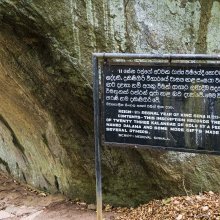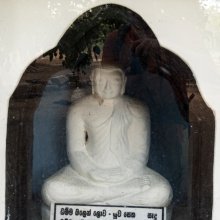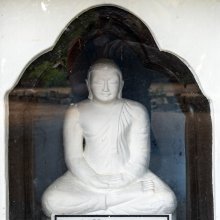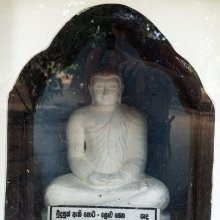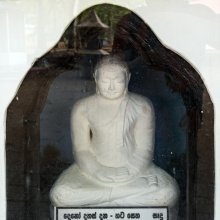Sena, Senā, Shena: 30 definitions
Introduction:
Sena means something in Buddhism, Pali, Hinduism, Sanskrit, Jainism, Prakrit, the history of ancient India, Marathi, Hindi, biology. If you want to know the exact meaning, history, etymology or English translation of this term then check out the descriptions on this page. Add your comment or reference to a book if you want to contribute to this summary article.
Images (photo gallery)
(+3 more images available)
In Hinduism
Shaivism (Shaiva philosophy)
Source: Manblunder: Sri Rudram 4.7-17Senā also means human body. Sensory organs are the soldiers and the chief of soldiers means the mind. Mind is the controller of all sensory organs.

Shaiva (शैव, śaiva) or Shaivism (śaivism) represents a tradition of Hinduism worshiping Shiva as the supreme being. Closely related to Shaktism, Shaiva literature includes a range of scriptures, including Tantras, while the root of this tradition may be traced back to the ancient Vedas.
Purana and Itihasa (epic history)
Source: archive.org: Puranic EncyclopediaSena (सेन).—Son of King Ṛṣabha. It is mentioned in Bhāgavata, Skandha 5 that this king had nineteen sons including Sena.
Source: Cologne Digital Sanskrit Dictionaries: The Purana IndexSena (सेन).—A son of Bṛhadratha.*
- * Matsya-purāṇa 48. 22.

The Purana (पुराण, purāṇas) refers to Sanskrit literature preserving ancient India’s vast cultural history, including historical legends, religious ceremonies, various arts and sciences. The eighteen mahapuranas total over 400,000 shlokas (metrical couplets) and date to at least several centuries BCE.
Jyotisha (astronomy and astrology)
Source: Wisdom Library: Brihat Samhita by VarahamihiraSenā (सेना) refers to “fighting men”, according to the Bṛhatsaṃhitā (chapter 2), an encyclopedic Sanskrit work written by Varāhamihira mainly focusing on the science of ancient Indian astronomy astronomy (Jyotiṣa).—Accordingly, “We shall now proceed to give a brief description of (the qualifications of) a jyotiṣaka. [...] He must be able to interpret the language and gestures of fighting men [i.e., senā] and the like; he must be learned in the Ṣaḍguṇa and Upāya policies; he must be able to predict the success or failure of an undertaking; he must be able to interpret omens; he must have a knowledge of favourable halting places for the king’s army; he must be able to interpret the colour of ceremonial fires; he must know when to employ the ministers, spies, messengers and forest men; he must be able to give directions touching the captures of the enemy’s fortress”.

Jyotisha (ज्योतिष, jyotiṣa or jyotish) refers to ‘astronomy’ or “Vedic astrology” and represents the fifth of the six Vedangas (additional sciences to be studied along with the Vedas). Jyotisha concerns itself with the study and prediction of the movements of celestial bodies, in order to calculate the auspicious time for rituals and ceremonies.
Shaktism (Shakta philosophy)
Source: Brill: Śaivism and the Tantric Traditions (shaktism)Sena (सेन) refers to the “armies (fighting a battle)”, according to the Mahābhārata 10.8.64–68.—Accordingly, “Good sir, they saw her, Kālarātri, standing, smiling, alone, blue-black in hue, with red mouth and eyes, garlands and unguents of crimson, red robes, a noose in one hand, a peacock feather [in her hair], binding men, horses and elephants with her horrifying fetters while she stood, capturing many headless ghosts trapped in her noose, leading those asleep in their dreams to other Nights. And at all times the best soldiers saw the son of Droṇa slaughtering. From the time when the battle between the Kuru and Pāṇḍava armies (kurupāṇḍava-sena) began, they saw [both] that evil spirit and the son of Droṇa. The son of Droṇa later felled those who had first been struck by this divinity [Kālarātri], terrorizing all creatures while shouting out ferocious bellows”.

Shakta (शाक्त, śākta) or Shaktism (śāktism) represents a tradition of Hinduism where the Goddess (Devi) is revered and worshipped. Shakta literature includes a range of scriptures, including various Agamas and Tantras, although its roots may be traced back to the Vedas.
Sports, Arts and Entertainment (wordly enjoyments)
Source: archive.org: Syainika Sastra of Rudradeva with English Translation (art)Sena (सेन) refers to “soldiers” (employed during hunting), according to the Śyainika-śāstra: a Sanskrit treatise dealing with the divisions and benefits of Hunting and Hawking, written by Rājā Rudradeva (or Candradeva) in possibly the 13th century.—Accordingly, [while discussing the outlines of hawking]: “The arrangements should be made thus: From the very first watch of the night until the morning clouds of autumn surround the sun, a large number of soldiers (aneka-sena) should be posted far and wide on all sides to guard against intrusion of other people, while: the king himself, surrrounded by a few distinguished and faithful champions, [...]”.

This section covers the skills and profiencies of the Kalas (“performing arts”) and Shastras (“sciences”) involving ancient Indian traditions of sports, games, arts, entertainment, love-making and other means of wordly enjoyments. Traditionally these topics were dealt with in Sanskrit treatises explaing the philosophy and the justification of enjoying the pleasures of the senses.
General definition (in Hinduism)
Source: archive.org: Vedic index of Names and SubjectsSenā (सेना) denotes primarily a ‘missile’, a sense found in the Rigveda and the Atharvaveda, and then a ‘host’ or ‘army’, which is its normal meaning. See Saṃgrāma.
In Buddhism
Theravada (major branch of Buddhism)
Source: Pali Kanon: Pali Proper Names1. Sena
King of Ceylon (Sena I., 831-51 A.C.). He was the younger brother and the successor of Aggabodhi IX. He had three younger brothers: Mahinda, Kassapa and Udaya. His queen was Sangha. During his reign the Pandu king invaded Ceylon, and Sena had to retire into the Malaya district. After the army of the Pandu king had plundered a great part of the kingdom, Sena made a treaty with him and re gained his throne. He adopted the three sons and the three daughters of Kittaggabodhi: Kassapa, Sena and Udaya, and Sangha, Tissa and Kitti. Among the kings good acts was the construction of a monastery on Aritthapabbata for the Pamsukulikas, and a many storeyed pasada in Jetavana. He also built the Virankurarama, the Pubbarama, Sangha sena parivena, Senaggabodhi vihara, a refectory in the Mahamettapabbata vihara, and single cells in the Kappura and Uttaralha parivenas. He completed the Dappulapabbata- and the Kassaparajaka viharas. Among Senas ministers were Bhadda (the senapati), Uttara, Vajira and Rakkhasa. His capital was in Pulatthinagara (Cv.l.1ff). He was also known as Silamegha (Cv.l.43).
2. Sena
Son of the Adipada Kassapa, and therefore nephew of Sena I. On the death of his father, Sena became king as Sena II. (851-85 A.C.). He married Sangha, daughter of Kittaggabodhi, and had a son, Kassapa. Sena sent an expeditionary force against the Pandu king, captured Madhura, and brought back the treasures which had been pillaged by the Pandus in the time of Sena I. The Pamsukulika monks separated from the incumbents of Abhayagiri in the twentieth year of Senas reign. He built the Manimekhala dam and a dam across the Kanavapi at Katthantanagara. He endowed various monasteries - Buddhagama, Mahiyangana, Kutatissa, Mandalagiri, and Sobbha - and held a special ceremony in honour of the image of Ananda. He held a consecration festival at the Hemavaluka cetiya (Maha Thupa), and decreed that this festival should be repeated annually. His senapati was Kutthaka. Cv.li.1ff.
3. Sena. Son of Kittaggabodhi. Cv.l.56.
4. Sena. Called Mahalekhaka Sena. He was a minister of Kassapa V. and built the Mahalekhakapabbata house in the Mahavihara (Cv.lii.33). His mother was Nala. Cv.Trs. i.138, n.3; 165, n.1.
5. Sena. Uparaja of Udaya III., and later Sena III., king of Ceylon (937-45 A.D.). According to some accounts he was the brother of Udaya III. He observed the uposatha day regularly, and among his benefactions was the Dandissara offering to mendicant artists. He made the stone paving of Abhayuttara cetiya and endowed the Nagasala parivena. Cv.liii.13, 28ff.
6. Sena. Uparaja of Udaya IV., and afterwards king of Ceylon (Sena IV. 953-6 A.D.). He was learned, and used to explain the suttantas in the Lohapasada. Because of his piety, the gods sent timely rain.
7.. Daughter of Kassapa, yuvaraja of Udaya II. She married the kings brothers son. Cv.li.93.
8. Queen of Udaya I. Cv.xlix.2.
Theravāda is a major branch of Buddhism having the the Pali canon (tipitaka) as their canonical literature, which includes the vinaya-pitaka (monastic rules), the sutta-pitaka (Buddhist sermons) and the abhidhamma-pitaka (philosophy and psychology).
Tibetan Buddhism (Vajrayana or tantric Buddhism)
Source: academia.edu: The Structure and Meanings of the Heruka MaṇḍalaSenā (सेना) (or Śyenā) is the name of a Ḍākinī who, together with the Vīra (hero) named Sena forms one of the 36 pairs situated in the Vāyucakra, according to the 10th century Ḍākārṇava chapter 15. Accordingly, the vāyucakra refers to one of the three divisions of the dharma-puṭa (‘dharma layer’), situated in the Herukamaṇḍala. The 36 pairs of Ḍākinīs [viz., Senā] and Vīras are dark blue in color; they each have one face and four arms; they hold a skull bowl, a skull staff, a small drum, and a knife.

Tibetan Buddhism includes schools such as Nyingma, Kadampa, Kagyu and Gelug. Their primary canon of literature is divided in two broad categories: The Kangyur, which consists of Buddha’s words, and the Tengyur, which includes commentaries from various sources. Esotericism and tantra techniques (vajrayāna) are collected indepently.
In Jainism
General definition (in Jainism)
Source: Wisdom Library: JainismSenā (सेना) is the mother of Saṃbhava according to Śvetāmbara (according to Digambara she is named Suṣeṇā), according to the Ācāradinakara (14th century work on Jain conduct written by Vardhamāna Sūri). Saṃbhava is the third of twenty-four Tīrthaṅkaras in Janism. A Tīrthaṅkara is an enlightened being who has conquered saṃsāra (cycle of birth and death), leaving behind him a path for others to follow.
The husband of Senā is Jitari. It is an ancient Jain practice to worship the Tīrthaṅkara’s parents in various rites, such as the pratiṣṭhāvidhi.
Source: archive.org: TrisastisalakapurusacaritraSenā (सेना) or Senādevī is the wife of Jitāri: an ancient king from Śrāvastī, according to chapter 3.1 [sambhava-jina-caritra] of Hemacandra’s 11th century Triṣaṣṭiśalākāpuruṣacaritra: an ancient Sanskrit epic poem narrating the history and legends of sixty-three illustrious persons in Jainism.
Accordingly: “[...] Among kings there was no one equal or superior to him like a lion among deer, like an eagle among birds. [...] His chief-queen was suitable because of a wealth of beauty, the general of the soldiers—the virtues, named Senādevī. Not injuring the other objects of existence, at the proper moments he sported with the queen like the moon with Rohiṇī. Now, the jīva of King Vipulavāhana completed his life in the ninth heaven. He fell from Ānata and descended into Senā’s womb on the eighth day of the white fortnight of Phālguna, when the moon was in conjunction with Mṛgaśiras”.

Jainism is an Indian religion of Dharma whose doctrine revolves around harmlessness (ahimsa) towards every living being. The two major branches (Digambara and Svetambara) of Jainism stimulate self-control (or, shramana, ‘self-reliance’) and spiritual development through a path of peace for the soul to progess to the ultimate goal.
India history and geography
Source: academia.edu: The Chronological History of Ancient Sri LankaTamil princes Sena and Gutta (probably, Velir princes) subjugated Sura Tissa and reined over Sri Lanka for 20 or 22 years. Prince Asela, the son of Mahashiva put Sena and Gutta to death and reigned ten years. Chola Prince Elara or Elala killed Asela and reined over Sri Lanka for 44 years. Sri Lankan Prince Abhaya Duttagamini, the son of Kakavanna, defeated Elala and reigned for 24 years.
Source: Shodhganga: Temple management in the Āgamas (history)Sena is the name of an ancient dynasty from Bengal where Shaivism thrived between the 10th and 12th centuries, according to Dr. Akhilesh K. Dubey (2005). He notes several grants to temples, Śaiva Brāhmaṇas and ascetics of śaiva mutts. The Cāhamānas (of Śākambharī, Jāvalīpura and Naḍḍūla), the Paramāras of Mālvā, Pālas and Senas of Bengal, the Gāhaḍavālas of Kanauj, the Candellas and the Kalacūrīs of Tripurī were all staunch Śaivites. There is also evidence of Śaiva Brāhmaṇas migrating from various places to propagate their wisdom and teachings.
Source: Shodhganga: Elements of Art and Architecture in the Trtiyakhanda of the Visnudharmottarapurana (history)Shena refers to a certain period in the history of Indian Art.—The chronological order of the development of Indian Art as stated in The Heritage of Indian Art is as follows—[...] 10. Pāla and Śena dynasties of Magadha and Bengal belongs to 700-1200 A.D. These two dynasties give great contribution towards the field of Art and Architecture. Brick temple of Paharpur, stone sculptures and bronzes are famous in that time.

The history of India traces the identification of countries, villages, towns and other regions of India, as well as mythology, zoology, royal dynasties, rulers, tribes, local festivities and traditions and regional languages. Ancient India enjoyed religious freedom and encourages the path of Dharma, a concept common to Buddhism, Hinduism, and Jainism.
Biology (plants and animals)
Source: Google Books: CRC World Dictionary (Regional names)1) Sena in Arabic is the name of a plant defined with Senna alexandrina in various botanical sources. This page contains potential references in Ayurveda, modern medicine, and other folk traditions or local practices It has the synonym Cassia acutifolia Delile (among others).
2) Sena in Malaysia is also identified with Pterocarpus indicus It has the synonym Lingoum rubrum Rumph. (etc.).
Example references for further research on medicinal uses or toxicity (see latin names for full list):
· Familles des Plantes (1763)
· Bulletin du Jardin Botanique de l’État (1954)
· Bulletin de l’Herbier Boissier (1908)
· Flore Forestière de la Cochinchine (1898)
· Species Plantarum. (1802)
· Ann. Soc. Sci. Bruxelles (1924)
If you are looking for specific details regarding Sena, for example pregnancy safety, diet and recipes, chemical composition, extract dosage, side effects, health benefits, have a look at these references.

This sections includes definitions from the five kingdoms of living things: Animals, Plants, Fungi, Protists and Monera. It will include both the official binomial nomenclature (scientific names usually in Latin) as well as regional spellings and variants.
Languages of India and abroad
Pali-English dictionary
Source: BuddhaSasana: Concise Pali-English Dictionarysena : (m.) a hawk. || senā (f.) an army.
Source: Sutta: The Pali Text Society's Pali-English DictionarySenā, (Vedic senā2 perhaps fr. si to bind) an army Vin. I, 241; IV, 104 sq. (where described as consisting of hatthī, assā, rathā, pattī), 160; S. I, 112; A. III, 397; V, 82; J. II, 94; Miln. 4; Nd1 95 (Māra°), 174 (id.).
— or —
1) Sena, 2 (Sk. śyena) a hawk J. I, 273; II, 51, 60; DhA. II, 267. (Page 723)
2) Sena, 1 (=sayana) lying, sleeping; couch, bed J. V, 96 (=sayana). (Page 723)

Pali is the language of the Tipiṭaka, which is the sacred canon of Theravāda Buddhism and contains much of the Buddha’s speech. Closeley related to Sanskrit, both languages are used interchangeably between religions.
Marathi-English dictionary
Source: DDSA: The Molesworth Marathi and English Dictionaryśēṇa (शेण).—n Dung of a bull, bullock, cow, or buffalo. Pr. śēṇa paḍalēṃ asatāṃ mātī ghēūna uṭhatēṃ. 2 Applied, with reference to the quality of softness and squashiness, to rotting fruits, flowers, leaves &c. 3 f A piece of cowdung, whether a cake formed through mashing, kneading, and drying, or a lump as lying on the ground. śēṇa as n denotes the material, śēṇa as f signifies a bit of it. śēṇa khāṇēṃ (To eat cowdung.) A phrase constantly in the mouth of the people concerning a person whom it is designed to revile as idling and dawdling, or as doing some foolish or fruitless action, or as making some nonsensical or irrelevant observations. See kēḷēṃ khāṇēṃ.
--- OR ---
śēna (शेन).—m (śyēna S) A hawk. śēnī f (śyēnī S) A female hawk.
--- OR ---
śēna (शेन).—ind A vulgar expletive explained under śī.
--- OR ---
sēnā (सेना).—f (S) An army, a force, a body of troops.
Source: DDSA: The Aryabhusan school dictionary, Marathi-Englishśēṇa (शेण).—n Dung of a cow, &c. f Piece of cowdung.
--- OR ---
śēna (शेन).—m A hawk.
--- OR ---
sēnā (सेना).—f An army, a force, a body of troops.
Marathi is an Indo-European language having over 70 million native speakers people in (predominantly) Maharashtra India. Marathi, like many other Indo-Aryan languages, evolved from early forms of Prakrit, which itself is a subset of Sanskrit, one of the most ancient languages of the world.
Sanskrit dictionary
Source: DDSA: The practical Sanskrit-English dictionarySena (सेन).—a. Having a lord, possessing a master or leader.
-nam The body.
--- OR ---
Senā (सेना).—[si-na, saha inena prabhuṇā vā Uṇādi-sūtra 3.1]
1) An army; सेना परिच्छदस्तस्य द्वयमेवार्थसाधनम् (senā paricchadastasya dvayamevārthasādhanam) R.1.19.
2) Army personified as the wife of Kārtikeya, the god of war; cf. देवसेना (devasenā).
3) A small army (consisting of 3 elephants, 3 chariots, 9 horse and 15 foot).
4) Any body of men.
Source: Cologne Digital Sanskrit Dictionaries: Shabda-Sagara Sanskrit-English DictionaryŚeṇā (शेणा).—f.
(-ṇā) Understanding, mind, intellect.
--- OR ---
Sena (सेन).—f.
(-nā) Adj. Having a lord.
--- OR ---
Senā (सेना).—f.
(-nā) 1. An army. 2. A goddess, commonly known by Deva-Sena, the personified armament of the gods, the wife of Kartikeya. 3. The mother of the third Jaina pontiff of the present era. E. ṣi to bind, nak and ṭāp aff.; or sa with, ina a lord or leader.
Source: Cologne Digital Sanskrit Dictionaries: Benfey Sanskrit-English DictionarySenā (सेना).—i. e. sa + na, f. 1. An army, [Vikramorvaśī, (ed. Bollensen.)] 11, 16. 2. The wife of Kārttikeya, the god of war.
Source: Cologne Digital Sanskrit Dictionaries: Cappeller Sanskrit-English DictionarySenā (सेना).—1. [feminine] missile, weapon.
--- OR ---
Senā (सेना).—2. [feminine] line of battle, army.
Source: Cologne Digital Sanskrit Dictionaries: Monier-Williams Sanskrit-English Dictionary1) Śeṇā (शेणा):—or śeṇavī f. (cf. ratna-śeṇā) Name of [work]
2) Sena (सेन):—1. sena mfn. (7. sa + ina) having a master or lord, dependent on another, [Vāsavadattā]
3) 2. sena (?) n. the body, [cf. Lexicographers, esp. such as amarasiṃha, halāyudha, hemacandra, etc.]
4) Senā (सेना):—f. ([from] √2. si) a missile, dart, spear, [Ṛg-veda; Atharva-veda]
5) Name of Indra’s wife (or his thunderbolt so personified), [Taittirīya-saṃhitā; Aitareya-brāhmaṇa; Vaitāna-sūtra]
6) an army, armament, battle-array, armed force (also personified as wife of Kārttikeya; ifc. also n(sena). ), [Ṛg-veda] etc. etc.
7) a small army (consisting of 3 elephants, 3 chariots, 9 horse, and 15 foot), [cf. Lexicographers, esp. such as amarasiṃha, halāyudha, hemacandra, etc.]
8) any drilled troop or band or body of men, [Bālarāmāyaṇa]
9) a kind of title or addition to the names of persons (also names of courtezans), [Sāhitya-darpaṇa] (cf. [Pāṇini 4-1, 152 etc.])
10) Name of a courtezan (abridged [from] kubera-senā), [Hemacandra’s Pariśiṣṭaparvan]
11) of the mother of Śambhava (the third Arhat of the present Avasarpiṇī), [cf. Lexicographers, esp. such as amarasiṃha, halāyudha, hemacandra, etc.]
12) Sena (सेन):—[from senā] 3. sena (for 1. 2. See [column]2), in [compound] for senā.
Source: Cologne Digital Sanskrit Dictionaries: Yates Sanskrit-English Dictionary1) Śeṇā (शेणा):—(ṇā) 1. f. Idem.
2) Senā (सेना):—(nā) 1. f. An army; Kārtikeya’s wife; mother of the 3d Jaina pontiff.
Source: DDSA: Paia-sadda-mahannavo; a comprehensive Prakrit Hindi dictionary (S)Senā (सेना) in the Sanskrit language is related to the Prakrit word: Seṇā.
[Sanskrit to German]
Sanskrit, also spelled संस्कृतम् (saṃskṛtam), is an ancient language of India commonly seen as the grandmother of the Indo-European language family (even English!). Closely allied with Prakrit and Pali, Sanskrit is more exhaustive in both grammar and terms and has the most extensive collection of literature in the world, greatly surpassing its sister-languages Greek and Latin.
Hindi dictionary
Source: DDSA: A practical Hindi-English dictionarySenā (सेना):—(nf) army, military; horde; (v) to hatch; (arch.) to serve; —[kī śākhāeṃ] arms; ~[gra/mukha] vanguard; ~[jīvī] a soldier; ~[dāra/~dhipa /~dhipati /~dhīśa /~dhyakṣa/~nāyaka/~nī /~pati /~pāla] commander, general (of an army); ~[patya] commandership; -[vyūha] a battle-array, strategic deployment of the forces; -, [khaṭiyā/cārapāī] to lie idly; to keep confined to bed for long.
...
Prakrit-English dictionary
Source: DDSA: Paia-sadda-mahannavo; a comprehensive Prakrit Hindi dictionary1) Seṇa (सेण) in the Prakrit language is related to the Sanskrit word: Śyena.
2) Seṇā (सेणा) also relates to the Sanskrit word: Senā.
Prakrit is an ancient language closely associated with both Pali and Sanskrit. Jain literature is often composed in this language or sub-dialects, such as the Agamas and their commentaries which are written in Ardhamagadhi and Maharashtri Prakrit. The earliest extant texts can be dated to as early as the 4th century BCE although core portions might be older.
Kannada-English dictionary
Source: Alar: Kannada-English corpusŚeṇa (ಶೆಣ):—[noun] the shrub, Crotolaria juncea of Papilionaceae family, the bitter leaves of which are used as an emetic in gastric and bilious fevers and cultivated extensively for its fibre; the sun hemp.
--- OR ---
Sēna (ಸೇನ):—[noun] any of numerous birds of prey of the family Accipitridae, having a short, hooked beak, broad wings, and curved talons, often seen circling or swooping at low altitude; a hawk.
Kannada is a Dravidian language (as opposed to the Indo-European language family) mainly spoken in the southwestern region of India.
See also (Relevant definitions)
Starts with (+211): Cena, Cenacamuttiram, Cenai, Cenai-perukani, Cenai-peruvanikan, Cenaikkal, Cenaimutaliyar, Cenainatan, Cenaipokam, Cenaippal, Cenaippataikal, Cenaittalaivar, Cenaiyarkon, Cenaiyulpatunan, Cenakan, Cenanam, Cenani, Cenapaticcaram, Cenapatiyalvar, Cenatipan.
Ends with (+368): Abhishena, Adhokshena, Adityasena, Advishena, Agrasena, Aharasena, Ajitasena, Akshayasena, Amarasena, Amgushthaprasena, Amitrasena, Anangasena, Anantasena, Anayasasena, Anayasena, Anekasena, Anicchasena, Anichchhasena, Apassena, Aprayasena.
Full-text (+880): Senapati, Senakula, Indrasena, Nrisena, Senaraksha, Devasena, Shenavi, Ugana, Varisena, Avyadhin, Padmasena, Yajnasena, Antahsenam, Senani, Shrisena, Senahan, Bharanishena, Vriddhasena, Vishvaksena, Ugrasena.
Relevant text
Search found 83 books and stories containing Sena, Senā, Shena, Śēṇa, Śeṇa, Śēna, Śena, Sēnā, Śeṇā, Seṇa, Sēṇa, Seṇā, Sēṇā, Sēna; (plurals include: Senas, Senās, Shenas, Śēṇas, Śeṇas, Śēnas, Śenas, Sēnās, Śeṇās, Seṇas, Sēṇas, Seṇās, Sēṇās, Sēnas). You can also click to the full overview containing English textual excerpts. Below are direct links for the most relevant articles:
Garga Samhita (English) (by Danavir Goswami)
Verse 6.7.8 < [Chapter 7 - The Marriage of Śrī Rukmiṇī]
Verse 6.4.38 < [Chapter 4 - Journey to the City of Kuṇḍina]
Verses 5.24.15-16 < [Chapter 24 - The Killing of the Kola Demon]
Rig Veda (translation and commentary) (by H. H. Wilson)
Warfare and Military System in Vedic Literature (by Rinki Deka)
Types of War in Vedic Period < [Chapter 4 - Principles and Ethics related to the Warfare]
Composition of Army < [Chapter 2 - Military System as Revealed in the Vedic Texts]
Marching to War and Seasons < [Chapter 4 - Principles and Ethics related to the Warfare]
Vastu-shastra (5): Temple Architecture (by D. N. Shukla)
Temples of Mayūrbhañja < [Chapter 12 - History of Hindu Temples (Prāsādas and Vimānas)]
Bhumija Temples < [Chapter 12 - History of Hindu Temples (Prāsādas and Vimānas)]
Temple architecture in Cambodia < [Chapter 12 - History of Hindu Temples (Prāsādas and Vimānas)]
Mahabharata (English) (by Kisari Mohan Ganguli)
Section CLVI < [Bhagavat-Yana Parva]
Section LX < [Bhagavat-Gita Parva]
Section CCXXIX < [Markandeya-Samasya Parva]
The Skanda Purana (by G. V. Tagare)
Chapter 28 - Preparations of Devas and Daityas for War < [Section 1 - Kedāra-khaṇḍa]
